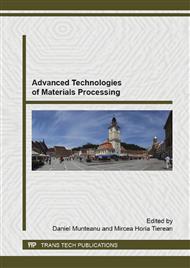p.3
p.10
p.18
p.26
p.35
p.44
p.51
p.58
Solidification Simulation of Parts with Rotational Symmetry Using 2D Software in Cylindrical Coordinates
Abstract:
Solidification simulation software was developed, for parts having rotational symmetry cast of eutectic alloys or pure metals. The software uses a finite differences mathematical model described in cylindrical coordinates. Unlike software in Cartesian coordinates, it allows the solidification simulation for three dimensional parts with rotational symmetry using 2D simulation. As result the effective simulation time is much smaller (tens or even hundreds of times) in comparison with simulation in Cartesian coordinates. Cylindrical coordinates have the advantage of allowing a precise reproduction of the round contour parts. The paper presents the experimental verification of the results provided by the software. Experimental verification is performed by thermal analysis. A cylindrical sample with a diameter D = 60 mm and length L = 150mm was cast. The part was cast in Al-Si eutectic alloy (ATSi12). The temperature variation inside casting was recorded in three points: in the center, at the distance 1/2R and on the part surface. The experimental results were compared with those determined by computer solidification simulation. The values for liquid alloy initial temperature and for landing eutectic temperature used in simulation were chose accordingly to those experimentally determined for each point separately. The temperature variation curves during casting cooling and solidification obtained by simulation are close to those experimentally determined. The curves approaching in the first part (cooling in liquid state and solidification) can be appreciated as very good. Small differences appear in the final of the curves in the cooling area after the complete solidification of the alloy in that point. The experiment revealed that the tested software provide accurate data on castings solidification (solidification time and temperature distribution). As result, the software developed by the authors from Transilvania University, can be used with enough accuracy for fundamental and applied researches related to castings solidification.
Info:
Periodical:
Pages:
10-17
Citation:
Online since:
October 2015
Authors:
Price:
Сopyright:
© 2015 Trans Tech Publications Ltd. All Rights Reserved
Share:
Citation:


